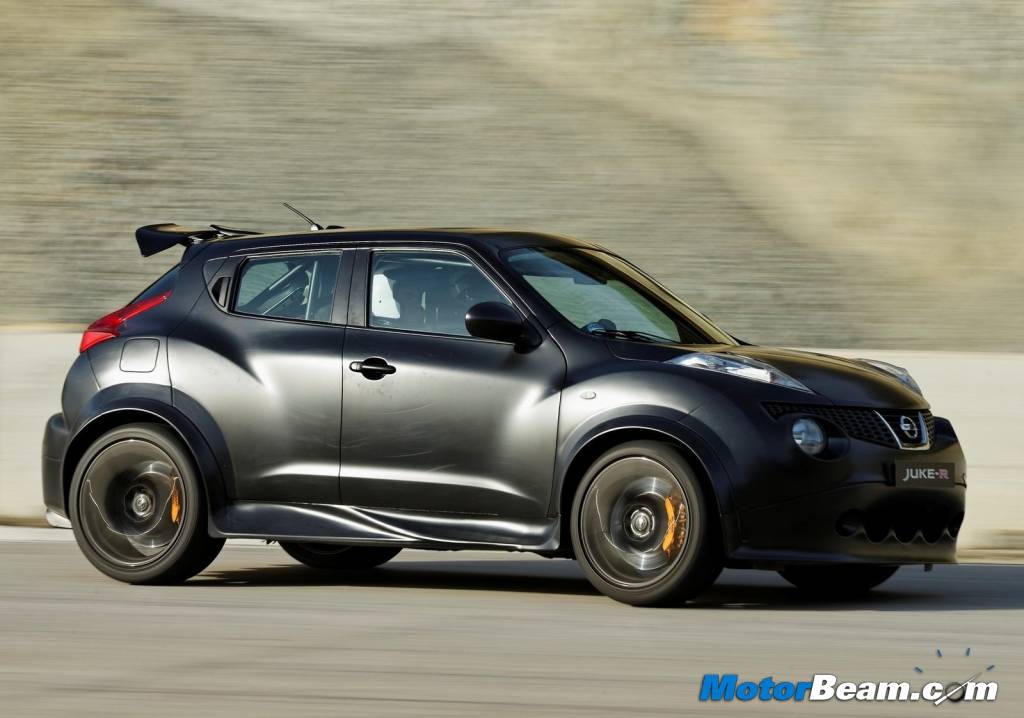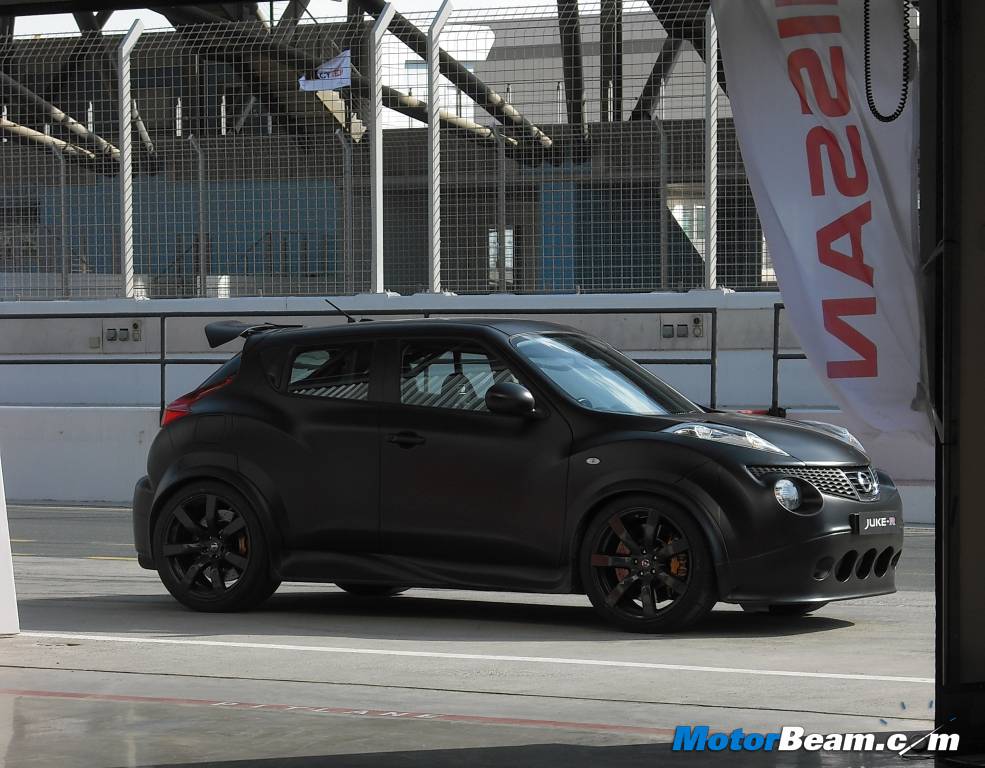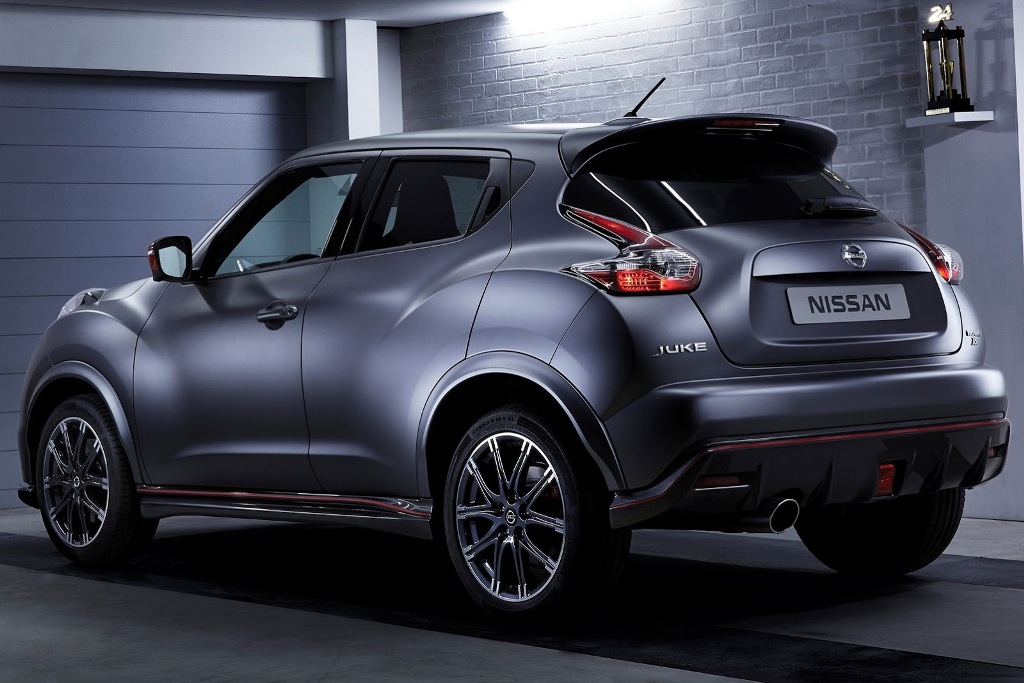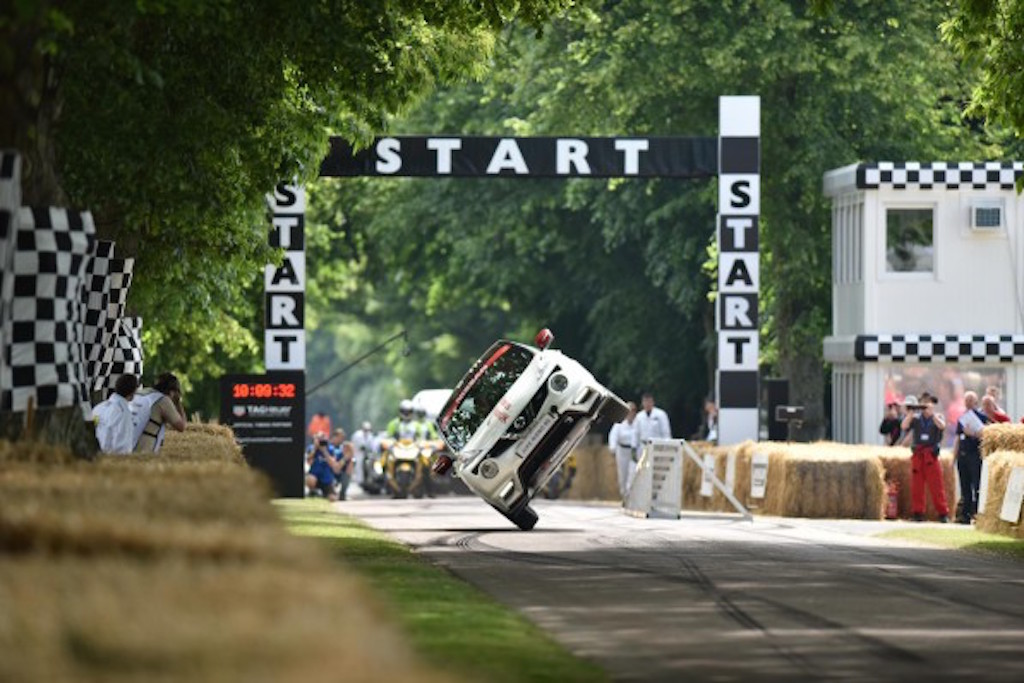The Juke-R is a result of a quirky idea and some cool engineering between a manufacturer and a specialist builder.
Nissan Juke-R Review
As motoring journalists, we do come across examples of intense engineering in the industry. And most of the radicalism is usually the handiwork of in-house tuner set-ups where a bunch of performance hungry engineers lend their magic touch to stock machines. But, what we witnessed with the Nissan Juke-R virtually pulverizes what we have been exposed so far. In what we would describe as the most radical piece of innovative engineering comes from Nissan who began sounding an idea to pump some steroids into its lifestyle Juke crossover SUV. The normal way to go about it would be to either bump up the engine’s existing power, change the transmission, tweak and stiffen the chassis and get some tarmac gripping rubber or at the most drop in a bigger displacement engine with bells and whistles.
Motor Quest: The Nissan Juke is a compact SUV which was launched in 2010. It has been a massive success but Nissan has no immediate plans to launch it in India. The Juke is smaller than the Duster/Terrano and is also offered with the same 1.5-litre k9k diesel engine.
[flickr size=”center” float=”medium”]http://www.flickr.com/photos/motorbeam/9612558729/[/flickr]
Not good enough said the boffins at Nissan. How about dropping the GT-R’s powertrain in the Juke instead? At first, this may seem a ludicrous idea, but that hasn’t stopped Nissan going ahead with such a project with both left and right hand drive models. Both variants have their creative origins in the UK as a result of a collaborative effort between Nissan’s Technical Centre Europe (NTC-E) and motorsports outfit Ray Mallock Limited. It took 22-weeks from start to finish and after a couple of teaser rounds about the concept. Technically, the Nissan Juke-R is not a production car but a special, road legal concept car. At first glance of this matte black car, when compared with the stock Juke, the Juke-R’s physical dimensions are closer to the stock Juke more than your regular GT-R. The car shares the same length and height but sports a 226 mm shorter wheelbase.
The Nissan Juke-R is wider (by 145 mm) with the front and rear tracks being asymmetric with extra flared wheel arches accommodating 20-inch RAYS forged alloy wheels shod with high performance low profile tyres. Performance related aerodynamic tweaks are also visible besides the sculpted side skirts/rocker panels, at the rear of the car there’s a dynamic split rear wing designed specifically to help the front heavy car with down-force at high speeds. Interestingly, there are no extra cooling arrangements such as oversized radiators or visible extra ducting. Mallock reconfirmed the cooling systems in the car were all stock from the GT-R
[flickr size=”center” float=”medium”]http://www.flickr.com/photos/motorbeam/9612559251/[/flickr]
A critical look at the packaging inside out reveals that this isn’t just a cut and paste job. First, it is clear to the trained eye that the Juke-R is not just a GT-R on a Juke body. We are aware of the dimensions of the GT-Rs powertrain and trying to retrofit this in the Juke has demanded a critical amount of engineering work to be done by RML. When it came to the Juke’s new engine, fitting a twin-turbo V6 (besides extra two cylinders and more than double the displacement) where a transversely-placed four-cylinder used to exist meant that the Juke’s stock floor pan had to be taken out entirely and a new fabricated floor along with a redesigned and stiffer bulkhead were created to accommodate the engine that now lives deep in the Juke’s cabin. To further reinforce the cabin and help in torsional rigidity, a custom fabricated roll-cage was welded in.
[flickr size=”center” float=”medium”]http://www.flickr.com/photos/motorbeam/9615797082/[/flickr]
Most of the other kit in the cabin come from the GT-R including the dashboard and instrumentation and 7-inch TFT screen. As a purely functional road legal car, there’s even mod cons such as air-conditioning, the stock GT-Rs audio system, multifunction steering wheel, bright red engine start button among others. However, the biggest change is in the car’s accommodation. Instead of keeping the base Juke’s five-seat layout, this modified car is strictly a two-seater with OMP racing seats. The designers and fabricators have done a great job in balancing form with function with key elements from both the GT-R and Juke with each clearly complementing each other. The dashboard is 4 inches closer to the driver and so is the central console, by an inch. This arrangement has ensured that the driver can still operate the touch screen and drivetrain switches.
[flickr size=”center” float=”medium”]http://www.flickr.com/photos/motorbeam/9612559361/[/flickr]
Under the bonnet and tightly placed in the engine bay is a familiar sight, which is the GT-R’s 485 BHP 3.8-litre V6 twin turbo engine from the pre-revised 2011 edition. While the Juke-R is marginally heavier than the GT-R, with this package it can still propel the car from a standing start to 100 km/hr in just 3.7 seconds, before continuing on to a top speed of 257 km/hr. The car’s suspension package which defines the handling is quite interesting. While Mallock did the majority of the developmental tuning as the build progressed, logging thousands of miles in the process it was found that a combination of components from two model years worked best. The front suspension comes from the 2011 model, while the rear is from the 2010 edition.
[flickr size=”center” float=”medium”]http://www.flickr.com/photos/motorbeam/9612559721/[/flickr]
Driving Impressions – The first thing I noticed when entering the Nissan Juke-R is that it feels like a luxury race car. However, one does note that the sitting position is different. In the Juke-R, you actually sit further back when compared to the standard car. Fully bolstered in OMP racing seats with five belts to ensure a tight fit, it’s still comfortable. Once I was strapped in, and with Michael Mallock as my co-passenger-cum-track guide, after a brief introduction he indicated I was ready to push the familiar starter button found in the GT-R to bring the Juke-R to life. Since the car was built in 2011, and the 2012 GT-R has some revisions (including a power bump and some minor exhaust acoustic changes), the engine note and exhaust note of the Juke-R is identical to the old GT-R.
[flickr size=”center” float=”medium”]http://www.flickr.com/photos/motorbeam/9612559805/[/flickr]
Once out of the pits, the first lap was a familiarity lap and when I first turn the wheel to join the track, I did note there’s a fair amount of nimbleness in the steering feedback not found in the GT-R (which I lapped on track before the Juke-R). The Juke-R feels much livelier and the instant gratification comes when the pedal meets metal and the tingling feel of weight shifting when slamming the brakes in particular. What surprised me was the initial turn-in capability, which is incredibly crisp and immediate. Even with the tight chassis, there’s a bit of body roll and the AWD system of the GT-R works its magic as expected.
[flickr size=”center” float=”medium”]http://www.flickr.com/photos/motorbeam/9615797132/[/flickr]
On the long straights on the track Mallock encouraged track experienced drivers to push the car to the limits, something which I would never push. With my reasonable track driving capabilities, I saw the speedometer needle over 208 km/hr and was extra cautious with hard braking zone, where I noted that the Juke-R had a tendency to get light in the back and wiggle its rear just a bit and by the time you realized it, the car has recomposed itself, just like the GT-R. It’s amazing how the intelligent electronics are able to give this crossover a planted feel, quite similar to the GT-R. Of course, one has to factor in the packaging of both cars (GT-R and Juke-R). In reality performance and handling can not be identical and this is attributed to the higher centre of gravity and shortened wheelbase of the Juke-R.
[flickr size=”center” float=”medium”]http://www.flickr.com/photos/motorbeam/9615797076/[/flickr]
I had real fun in ensuring that the car’s low-profile performance tyres really worked hard for grip and at the same time managed to manoeuvre the vehicle incredibly hard through and out of corners. It’s a uniquely amazing driving experience and given a bit more time, four-wheel drifts out of any corner would be just a natural extension. The Juke-R is real fun to drive, thanks in part to the GT-R’s double-clutch transmission, which requires you to do nothing more strenuous than grab the gear selector and slot it into ‘A’ for automatic shifts or ‘M’ if you want to use the steering wheel-mounted paddle shifters. At just over 1800 kgs (around 60 kgs more than the GT-R) the Juke-R is no flyweight, but with all that power and torque it is able to exhibit similar physics defying feel as Nissan’s iconic flagship. The idea of giving the car a shorter wheelbase and wider asymmetric track does make it so agile, especially the way it turns into to corners.
[flickr size=”center” float=”medium”]http://www.flickr.com/photos/motorbeam/9615796084/[/flickr]
Verdict – By far, there’s no dispute that the Juke-R is one of the most exhilarating vehicles currently wearing a Nissan badge and this near-500 BHP Juke-R is an incredible machine. While there’s Nissan’s in-house Nismo which could bring up its own version of a souped up Juke, while appreciating the fact that for now, Nissan says this is a PR exercise, we think it will be hard for Nissan to ignore the tremendous reception the Juke-R has already received throughout out the world. In fact, two production models have been sold to high profile sheikhs in UAE while three more are confirmed. What we do know now, these cars will be unique, niche and extremely limited in numbers and will considerably appreciate in value in the coming years.
[flickr size=”center” float=”medium”]http://www.flickr.com/photos/motorbeam/9612560935/[/flickr]
Nissan teamed up with Ray Mallock Racing, which has worked closely with the company’s motorsport projects for the past two decades, running the R90C prototype at Le Mans in 1990 and the 90s BTCC team. Ray Mallock also developed the Micra-R in 2003, a supercar with a Nissan Primera race engine where the rear seats used to be. It’s that car which inspires the new Juke-R.
Q & A with Michael Mallock
MotorBeam – What made Nissan go for this idea?
Michael Mallock – It started as an idea to add more fun in the Juke. From the onset it was clear that the Nissan Juke-R is not a production car but a special, road legal concept car.
MotorBeam – How were you involved?
Michael Mallock – We were approached by Nissan to create two versions of the Nissan Juke-R – one in left-hand-drive and one in right-hand-drive and as you can see, both cars are here in Dubai.
MotorBeam – How long did it take to complete the project?
Michael Mallock – From idea conception, approval and engineering to final sign off, 22 weeks.
MotorBeam – What were the major engineering considerations?
Michael Mallock – Since this crossover SUV was to be performance oriented with the genes of the GT-R, RML had to design the engineering package in such a way that it complemented the packaging over all as per intentions. We had plenty of information on the Juke and GT-R, so we had the ability to figure out theoretical spring, anti-roll bar, sway bar, and damping rates needed. Components for the suspension comes from 2010 and 2011 modes of the GT-R, but firmness was increased significantly to help minimize body roll, as everything on the Juke R had to be stiffer and firmer.
MotorBeam – Obviously, this is no ordinary job. What’s been the most difficult part of the assignment?
Michael Mallock – The most difficult bit I would say was packaging. As you know, the GT-R has a big driveline, so we always knew that was going to be a challenge getting that into the Juke body. Besides floor pan and bulkhead modifications, we had to reduce the wheelbase of the stock Juke by 9.8in.
MotorBeam – How did the sign off take place?
Michael Mallock – We worked closely with Nissan’s Tech Center in Europe throughout the process. When both sides were satisfied with the car, we had experts from Nissan to drive the vehicle to confirm its findings. Both companies worked together on the final sign-off procedure to get the two vehicles certified for dynamics and safety.





